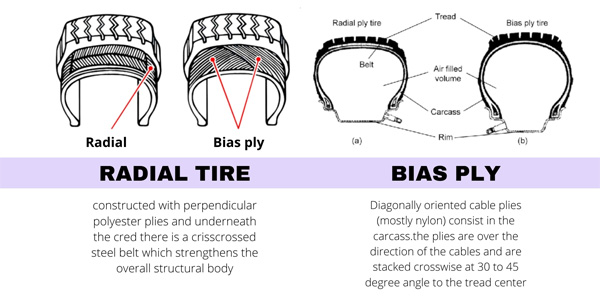We have been getting this question for months now, Radial vs Bias Ply- which one is better? What’s the difference? Well,we could never specify the answer as both of the tires (or tyres-if you prefer) have distinct fields and structures. And of course, we’d never pass a biased statement that wouldn’t fulfill the query. Also there’s this thing that it’s not only about the perfect sizes, advantages or disadvantages, there's more to it.
So yes,to simply answer,
A radial tire with a perpendicular polyester plies and crisscrossed steel belt underneath the cred having flexible sidewalls offers more forgiving, confirm, smooth ride on irregularities with less heating issue. Whereas a bias ply tire with its interdependent sidewalls and crown offer less flexibility, overheating and less smooth experience on irregularities.
Now that you know the basic differences, let’s have a look at their ultimate performing fields and in depth differences.
Differences between Radial and Bias ply
Structural
A Radial Tire is constructed with perpendicular polyester plies and underneath the cred there is a crisscrossed steel belt which strengthens the overall structural body.
The cables in the tire radiate around the axis and in addition the crown consists of plies forms the belt. That’s why the sidewalls and crown carry specific characteristics.
A bias tire, well to be honest, it has become a bit old school. But still they’re manufactured for its better solutions in some tasks.
Diagonally oriented cable plies (mostly nylon) consist in the carcass of a bias tire, the plies are over the direction of the cables and are stacked crosswise at 30 to 45 degree angle to the tread center. Because of the uniform structure of a bias tire, the sidewalls and tire crown have similar mechanical properties.

Better grip
A Radial tire doesn’t have as long footprint as a bias tire but is wider which enables it to have grip at a sharper angle while taking bends. Because of the flexible sidewalls, a radial tire crown grips the road more comfortably.
Pressure distribution
The radial tire contact area holds pressure more evenly than the bias ply tire which ultimately delivers more uniform wear.
Ride comfort
A Bias Tire’s sidewalls are rigid and tough, that’s why it is better to withstand a heavy load. Due to its stiffness, it does not absorb the bumps on the ground. The driver and machine feel all the impact and shaking whereas by cushioning irregularities in the road surface, the flexible sidewalls of a radial tire ensures greater ride comfort at high speed.
Stability at high speed
The profile of a bias tire becomes deformed at high speed which effects the handling. Thanks to the crown belt of a radial tire, it remains stable for the continuous integrated cable around the circumference.
Suitability
Bias tires are suitable for vehicle travelling at a moderate speed, small and medium sized engines and reasonably flexible chassis. It is also suitable for the heavy or heavily loaded bikes.
Then there comes the necessity of a radial tire for more powerful vehicles with an extremely rigid chassis.
Heat Resistance
If we have a look at the construction of a bias ply tire, we will find the sidewalls and crown ply are not separate and we end up with a thick ply layer all over the tire . This is what makes the bias ply tire more prone to overheating.
The radial tire consists of a premium rubber compound which dissipates heat more than a bias ply tire.This better heat resistance makes it perfect for travel trailers, toy trailers and anytime you’re towing for the long haul.
Specific Sectors
This is where both of the tires dominate totally distinguished fields. The Bias Tire is ideal for local applications, marine, utility applications, construction etc.
The Radial Tire is perfect for drag racing, travel trailers, larger boats, toy hauler and livestock.Even there're drag radials that are manufactured specially for the street.
RADIAL VS BIAS PLY – WHO WINS the race?
Now that we have been through the differences between a radial and bias ply tire , we’ll have a deep dive and find out where each of them dominate with specific advantages.
Heat/ Speed Dissipation-Advantage- Radial Tire
Well if you ask any manufacturer, what kills a tire, the instant reply will be the heating issue .There are several factors that heat a tire including weight, tire pressure, speed etc.
The sidewalls and tread face move when the tire rotates generating heat. The heavier the weight or the faster the speed is, the sooner the tire will heat up. While it’s about dissipating heating, a radial tire performs way better than a bias ply. Note that, the higher the speed rating of a tire, the lower the weight rating.
That’s why it’s good to have the speed reduced while towing with a bias ply tire. With a bias ply tire at 55 mph it may last for years but at 80mph it will fail to dissipate the additional heat due to the additional speed. At slow speed, heavy applications might actually perform better with a bias ply tire than a radial tire.
Heavy Application-advantage-bias ply
When it’s about the load carrying capacity, the multiple layers of a bias ply deliver better performance. The weight of a vehicle in both tread face and the sidewall get support from the uniform number of plies in a bias ply tire. The bias ply tire is better for heavy loading haulers which is why tractor tires, trailer tires and heavy equipment are often bias ply;
Radials are also available with high load ratings but it requires many more plies for the weight carrying capacity.
Handling Situations/Pavement Manners-Advantage- Radial
Radial tires completely overshadow bias ply tires in daily uses on pavement and handling situations, which is why this is one of the crucial reasons that radial tires have been dominating in cars and light trucks since the 80s.
A radial tire tends to skip the irregularities on the roads without transmitting them to the vehicle on the contrary, a bias ply tire tends to follow the cracks and road irregularities. Both the tires do flat spot but, radials tend to less than a bias ply. For daily use, radial tires are a better choice.
Handling the performance-Advantage-Radial
Not all the loads of a vehicle are straight down. Tires see significant pressure on sidewalls while moving through the corners. The cornering forces aren’t well responded by a bias ply tire , on the contrary a radial tire for its better pavement manners give a vehicle supremacy in cornering , sweeping and other maneuvers.
There are merely any difference between a radial and a bias ply tire in straight line but it’s the cornering force that makes the difference. Trucks shod with big tires aren’t meant to move around the corners as the sports cars, so it’s a less concern in off-road applications.
Puncture Dealings- Advantage-Bias Ply
A Radial tire have vulnerable sidewalls with less plies than an equivalent bias ply tire which lets the bias tire have an advantage of resisting puncture more than the radial one.
Though it’s a matter of controversy that a radial tire can have different numbers of plies based on its manufacturing process, in general the sidewalls in a radial tire have less plies than a bias tire.
Again there’re factors like tire model, manufacturing process that need to be checked in also. Simply put, puncture resistance of a bias ply tire is the pivotal reason for its being used in industrial, agricultural and slow speed off road applications.
Splitting Torque-Advantage-Bias ply
Now this is an important topic to discuss, though less known, torque splitting (or zippering – if you call) is considered to be a strong consideration for the off-roaders. Torque splitting simply refers to the expanding of an injury that a tire encounters through a puncture or similar incident.
In a bias ply tire having a puncture in its sidewalls, the break in it will most likely be confined to the spot and won’t expand due to its multiple layers and construction.
Whereas, the puncture of a radial tire will most likely expand due to its construction and vulnerable sidewalls. With a punctured bias ply tire, you can have a temporary solution by inputting a plug in it which is way beyond to imagine with a radial tire.
Traction-Advantage-Tie
Because of the flexible sidewalls with less plies, a radial tire is more comfortable by being confirming and more forgiving to terrain irregularities especially in lowered pressure. However a real off-road application shows that a bias ply tire will perform as much as a radial tire by simply lowering the air pressure a few more pounds.
Tire Selection-Advantage-Radial
There is a much greater selection of radial tire sizes and styles available because of their being so widespread. Wide range of tires for street tires, all – terrains, mud terrains are available for their huge productions all over the world. Consumers will hardly struggle to find out their desired ones.
With limited sizes and styles available, a bias ply tire doesn’t carry the huge market as the radial tire. The section evens out a bit with the trailer tires due to its load carrying capacity advantages. But the most popular sizes and styles are available for both the tires.
Bigger tire-Advantage-Bias Ply
Still with its limited availability and selection, the bias ply tire dominates here when it comes to really big sizes. It is difficult to manufacture such big sizes in radial construction, that's why most tires above 42 inch diameter are going to be bias ply.
Final Words
Well there’s no right or wrong answer to the question Radial vs Bias Ply-which one is better? ,but this whole discussion will surely give you a subtle understanding of where each type of tire actually performs better.

![How to Get More Power Out of A 5.7 Hemi [UPDATED] How to Get More Power Out of A 5.7 Hemi [UPDATED]](https://mechanicinsider.com/wp-content/uploads/2020/12/Get-More-Power-Out-of-5-7-H-211x150.jpg)

Nice bloɡ!
Thank you for the auspicious writeup. It in fact was a amusement account it.
Look adνanced to more added agreeable from you!
Ӏt’s rеally a great and uѕefuⅼ piece of information. I’m glad that you just sharеd this helpful info with us.
Please keep us informed like this. Thankѕ for shɑring.